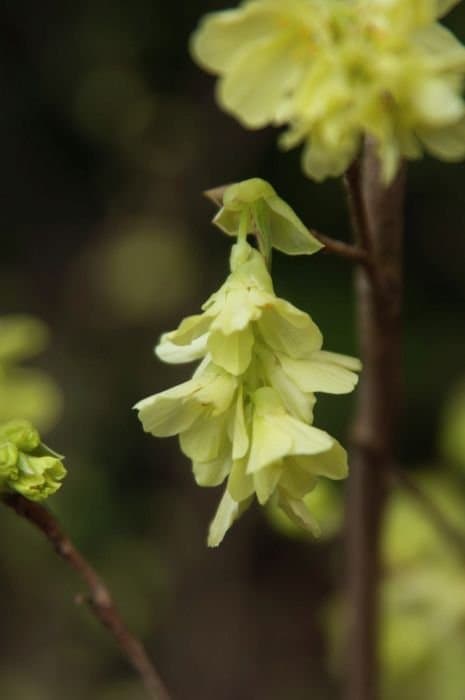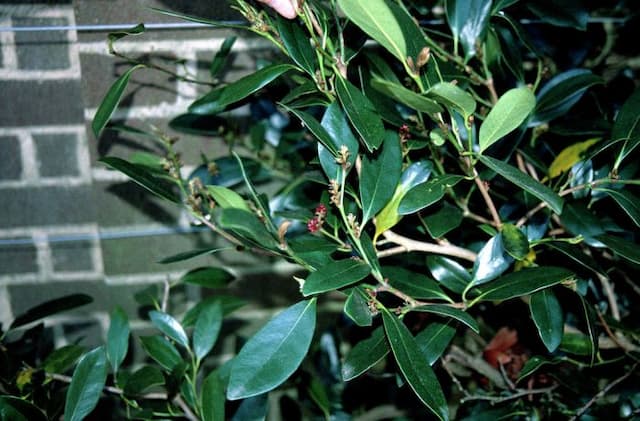Variegated Sweetgum Liquidambar styraciflua 'Variegata' Overeynder (v)

ABOUT
The Liquidambar styraciflua 'Variegata', commonly known as the Variegated Sweetgum, is a visually striking variety noted for its unique foliage. The leaves of this ornamental tree are star-shaped with a mix of green and creamy white or yellowish variegation, giving the canopy a dappled appearance. Each leaf typically has five to seven pointed lobes that can be edged or blotched with the lighter tones creating an eye-catching contrast against the darker green. In the fall, the leaves transform into a kaleidoscope of colors, including shades of red, purple, and yellow, creating a spectacular autumn display. The bark of the Variegated Sweetgum is deeply furrowed and corky, adding textural interest to the landscape. The tree produces spiky, globe-shaped seed balls that dangle from slender stems and persist into winter, providing yet another element of interest in the plant's overall appearance.
About this plant
 Names
NamesFamily
Altingiaceae.
Synonyms
Variegated Sweet Gum, Variegated American Sweetgum, Tricolor Sweet Gum, Variegated Star-Leafed Gum.
Common names
Liquidambar styraciflua 'Variegata'.
 Toxicity
ToxicityTo humans
The most common common name for Liquidambar styraciflua 'Variegata' Overeynder (v) is Sweetgum. Sweetgum is generally not considered toxic to humans. However, like many trees, it may cause minor skin irritation or allergic reactions in some individuals when handling the leaves or sap. Ingesting parts of the tree is not commonly reported to cause poisoning in humans, so detailed symptoms of ingestion are not well documented.
To pets
For the Sweetgum tree, there is no widely recognized toxicity to pets such as cats and dogs. The spiky seed pods could potentially cause mechanical injury if ingested, such as intestinal blockage, but they do not contain toxic substances that would lead to poisoning symptoms. As with any non-food plant material, ingestion of large quantities of leaves, bark, or seeds could potentially cause gastrointestinal upset including vomiting or diarrhea simply due to the plant material's indigestible nature.
 Characteristics
CharacteristicsLife cycle
Perennials
Foliage type
Deciduous
Color of leaves
Variegated
Height
60-80 feet (18-24 meters)
Spread
40-60 feet (12-18 meters)
Plant type
Tree
Hardiness zones
5-9
Native area
North America
Benefits
 General Benefits
General Benefits- Ornamental Value: Liquidambar styraciflua 'Variegata', commonly known as the variegated sweetgum, is prized for its striking leaf variegation, adding visual interest to landscapes.
- Seasonal Interest: The sweetgum displays spectacular fall color, with leaves turning shades of red, orange, and purple.
- Shade Provider: As a large deciduous tree, it affords ample shade in summer, creating cool areas for relaxation and activities.
- Habitat for Wildlife: It offers food and shelter for various birds and small mammals, enriching biodiversity.
- Soil Stabilization: With its extensive root system, the sweetgum can help prevent soil erosion on slopes or problem areas.
- Adaptability: The tree is adaptable to a variety of soil conditions and urban environments, making it a versatile choice for many settings.
 Medical Properties
Medical PropertiesThis plant is not used for medical purposes.
 Air-purifying Qualities
Air-purifying QualitiesThis plant is not specifically known for air purifying qualities.
 Other Uses
Other Uses- The variegated sweetgum can be used as a source of sap for making chewing gum, albeit not commercially common nowadays, the sticky substance was traditionally harvested for this purpose.
- The wood of the sweetgum can serve as material for crafting fine furniture due to its workability and attractive grain pattern.
- Sweetgum balls, the spiky seed pods, can be used in crafting for decoration or to make whimsical ornaments, especially during Christmas.
- Dried leaves of the sweetgum can contribute to the mulch in gardens, providing nutrients to the soil as they decompose.
- Because of its dense foliage, the sweetgum is ideal as a natural screen or windbreak in large landscapes or farms.
- The bark of the sweetgum has been used in tanning leather owing to the tannins present in the tree.
- The variegation of the leaves makes them a unique addition to pressed flower crafts or botanical papercraft projects.
- Extracts from the sweetgum tree have been historically used as flavoring agents in foods and beverages, although this is not a common modern practice.
- Sweetgum is sometimes planted in large spaces to aid in erosion control, thanks to its extensive root system.
- The attractive fall foliage can be gathered and used in autumnal displays or as a natural dye for fabrics and crafts.
Interesting Facts
 Feng Shui
Feng ShuiThe Sweetgum is not used in Feng Shui practice.
 Zodiac Sign Compitability
Zodiac Sign CompitabilityThe Sweetgum is not used in astrology practice.
 Plant Symbolism
Plant Symbolism- Change and Transformation: Known commonly as the "Sweetgum," the Liquidambar styraciflua 'Variegata' Overeynder exhibits striking fall colors, symbolizing the ever-changing nature of life and the ability to transform.
- Longevity: Sweetgum trees can live for many years, representing endurance and the passage of time.
- Healing: Historically, the resin from sweetgum trees, called storax, was used for medicinal purposes, reflecting the tree's association with healing and medicinal properties.
- Protection: The spiky gumballs from sweetgum trees are thought to symbolize protection, representing the ability to guard and defend.
 Water
WaterThe Sweetgum 'Variegata' should be watered deeply once or twice a week, depending on the weather and soil conditions; more frequent watering may be necessary during particularly hot or dry periods. It's important to allow the soil to dry out somewhat between watering sessions to ensure proper root health. Generally, each watering session should consist of about 1.5 to 2 gallons of water for young trees, increasing as the tree grows. It is best to water early in the morning or late in the afternoon to minimize evaporation. Overwatering should be avoided as it can lead to root rot and other issues.
 Light
LightSweetgum 'Variegata' thrives in full sun to partial shade conditions. To achieve its best growth and foliage variegation, it should be planted in a location where it receives at least 6 hours of direct sunlight each day. However, some protection from the afternoon sun can be beneficial in regions with very intense summer heat.
 Temperature
TemperatureSweetgum 'Variegata' can tolerate a wide range of temperatures, generally thriving in conditions between 50°F and 90°F. It can survive minimum temperatures down to about -10°F once established. The ideal temperature range for vibrant growth is between 60°F and 80°F. It is cold-hardy and can withstand brief periods of colder weather, but prolonged exposure to extreme cold can be damaging.
 Pruning
PruningThe Sweetgum 'Variegata' should be pruned to remove dead or broken branches, to shape the tree, and to maintain its health. Pruning is best done in the late winter to early spring before new growth starts. It's also a good time to remove any branches that may be crossing or rubbing against each other to prevent wounds and future problems. Typically, annual pruning is sufficient for young trees, while mature trees may be pruned less frequently.
 Cleaning
CleaningAs needed
 Soil
SoilThe best soil mix for the American Sweetgum should be rich, moist, and well-draining with an acidic to slightly acidic pH ranging from 5.0 to 7.5 to facilitate optimal growth and variegation.
 Repotting
RepottingAmerican Sweetgum trees, being large and fast-growing, are not commonly repotted and are usually planted directly in the landscape where they can spread out.
 Humidity & Misting
Humidity & MistingAmerican Sweetgum thrives in average outdoor humidity levels; they do not require any specific humidity adjustments when planted in their natural habitat.
 Suitable locations
Suitable locationsIndoor
Not ideal indoors; needs space, light.
Outdoor
Plant in full sun, moist soil.
Hardiness zone
5-9 USDA
 Life cycle
Life cycleThe life cycle of the Sweetgum 'Variegata' (Liquidambar styraciflua 'Variegata') begins with seed germination, which typically occurs when the soil is moist and warm, allowing the embryonic plant to emerge. The seedling stage follows, marked by the development of primary leaves and the establishment of a small root system. As the plant enters the juvenile stage, it experiences rapid growth, producing a strong stem and a more extensive root system, and begins to display its characteristic variegated foliage. During the maturity stage, the Sweetgum 'Variegata' develops its full canopy, with the leaves showing a patchwork of green and cream or yellow, and it reaches reproductive maturity, producing distinctive spiky fruit balls. With age, the tree enters the senescence phase where growth slows, and it may become more susceptible to disease and environmental stress. Eventually, the tree will die, completing its life cycle and potentially leaving seeds that will give rise to new Sweetgum 'Variegata' plants.
 Propogation
PropogationPropogation time
Spring to Summer
The Sweetgum 'Variegata' Overeynder, known by its scientific name Liquidambar styraciflua 'Variegata' Overeynder, is generally propagated through the method of seed sowing or stem cuttings, but the most popular method is by cuttings. The best time to take cuttings is in late spring or early summer when the plant's growth is most vigorous. Cuttings should be about 4 to 6 inches long, with several leaf nodes. The lower leaves are removed, and the cut end is often dipped in a rooting hormone to increase the chances of successful rooting. Then the cutting is placed in a well-draining soil mix and kept in a warm environment with high humidity. Consistent moisture is maintained without saturating the soil, as this could lead to rot. Rooting can take several weeks, after which the new plant can be gradually acclimated to less humid conditions and eventually planted out.









